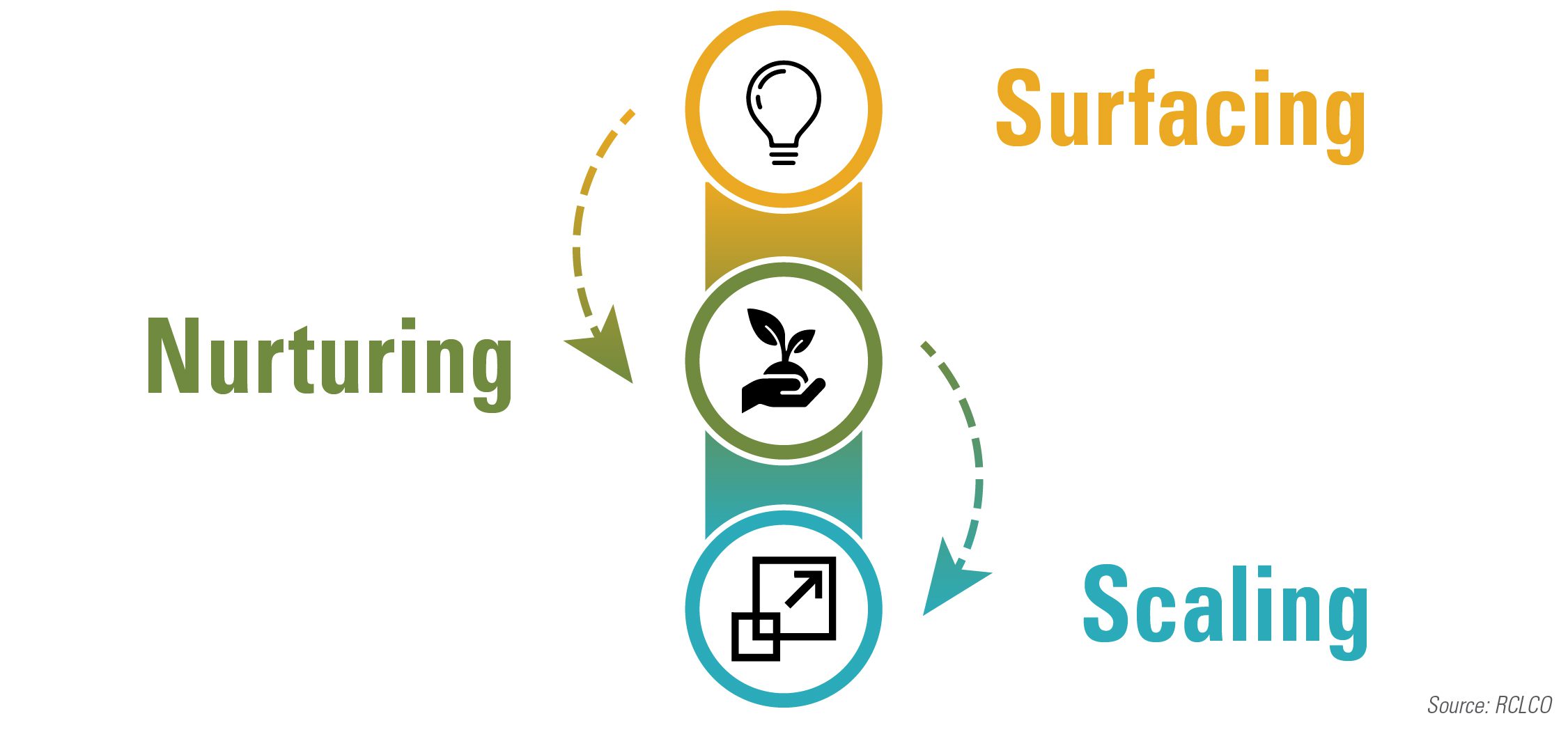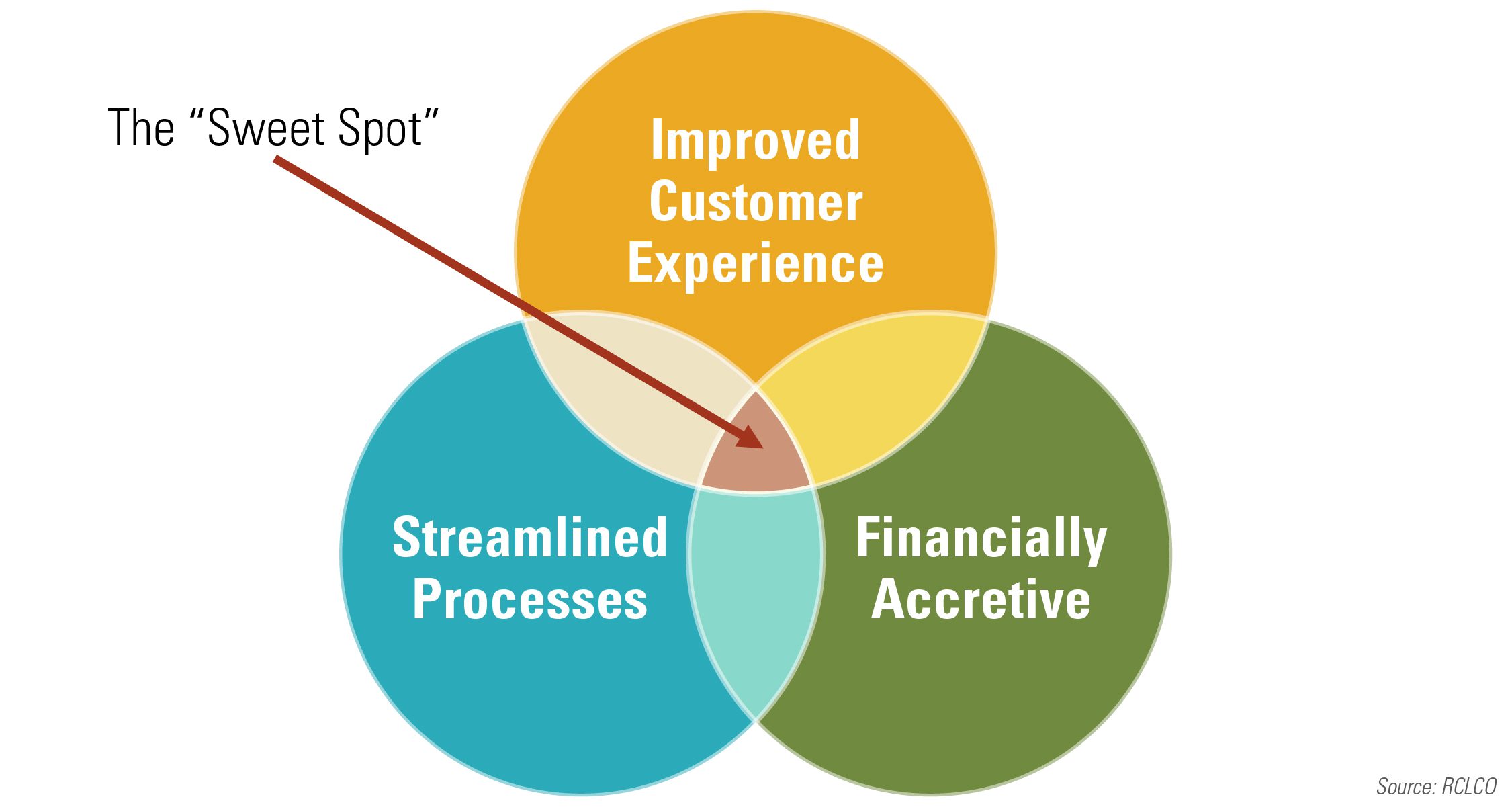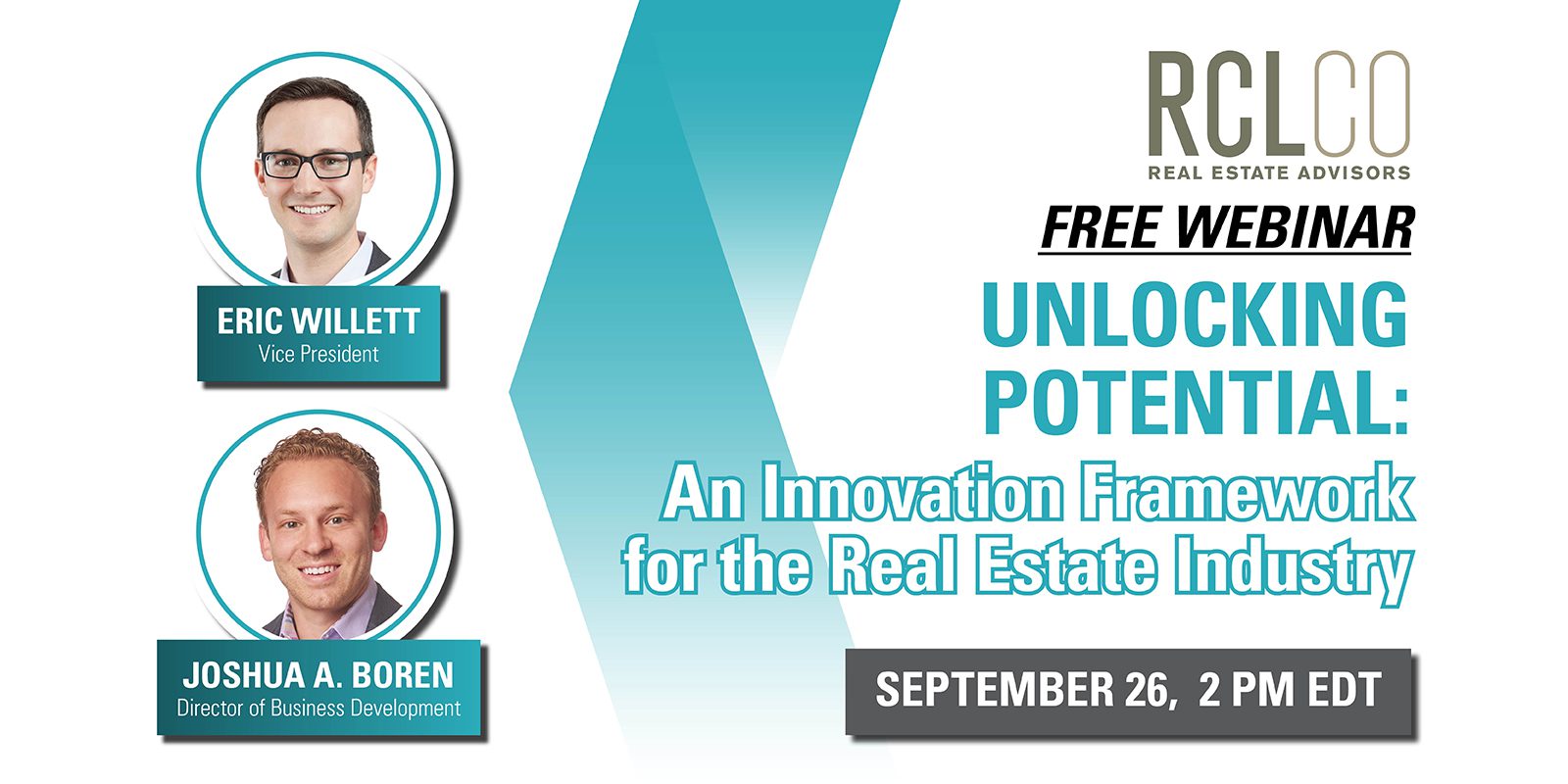Unlocking Potential: An Innovation Framework for the Real Estate Industry

Three things to know:
- The real estate industry’s most sophisticated innovators recognize that innovation is a set of interrelated activities—surfacing, nurturing, and scaling—that require complementary but distinct strategies.
- Surfacing innovative ideas works best when innovations are drawn from all levels of an organization: top-down, bottom-up, and outside-in.
- Nurturing new concepts to viability is more important than winnowing down potential ideas. Companies build support for innovation by fostering an internal culture that is willing to accept risk and developing internal resources to nurture ideas.
For decades, the real estate industry has been slow to adapt to changing technology, consumer preferences, or process improvements. Today, that reality is changing. Billions of dollars are being invested in the nascent PropTech space; maturing institutional real estate companies are developing dedicated R&D teams; and, the evolution of real estate products—convergence of hospitality with multifamily, redefinition of office in the sharing economy, retail merging with e-commerce—has changed the way industry leaders think about future-proofing their organizations. Motivated by these changes, RCLCO set out to determine what defines an effective innovation infrastructure for real estate companies. Our findings, described below, build on our work with dozens of companies at the forefront of real estate’s evolution and the lessons these companies have learned as they aim to integrate innovation in their organizations.
Innovative ideas take myriad forms, encompassing the physical, experiential, and digital environments that intersect with real estate. Across the industry, companies are exploring a staggering range of new ideas in these categories. The greatest commonality among real estate companies that are successfully innovating is a shared recognition that innovation is not an activity itself, but a set of interrelated activities that require complementary—but distinct— strategies. In surveying the real estate sector, nearly all firms with robust innovation pipelines are able to point to intentional efforts that speak to each step in RCLCO’s innovation framework.
RCLCO Innovation Framework

Surfacing
Developing a sourcing mechanism for new ideas is foundational to unlocking a company’s innovation potential. If the initial set of ideas is too narrow or constrained, inevitably, innovation is circumscribed in its ability to create transformative outcomes. As an executive at a national diversified real estate company said, “you want as large of a net as possible; that’s how you capture the full range of creative thinking.” Indeed, groups that emphasize “creating” ideas or “coming up” with a path forward frequently miss the breadth of creativity already embedded in an organizational structure.
RCLCO’s experience demonstrates that the companies innovating most successfully embrace a holistic set of strategies to surface innovative ideas broadly. In contrast, companies that consider surfacing too narrowly—often developing an innovation team without ground-level support or asking for new ideas with no centralized resources—are unable to drive meaningful improvements. Companies find that the optimal solution, then, is to embrace a mutually reinforcing set of strategies that encourage and support innovation from all directions: top-down, bottom-up, and outside-in.
Surfacing Toolkit

Top-Down
Building senior-level focus on innovation within a company is the first step. Top-down barriers to innovation can be both cultural and structural. At one national REIT, the cultural unwillingness to accept failures was an impediment. As an innovation executive described, “failure, whether that is wasted time or wasted money, is a necessary part of innovation,” and that required a change-of-mindset for company executives: “we have to communicate constantly and consistently that we believe in innovation, and we are clear-eyed about what that means.”
“We have to communicate constantly and consistently that we believe in innovation, and we are clear-eyed about what that means.”
The best companies develop top-down structures to complement an innovation-forward culture, frequently in the form of executive support for a centralized innovation or research & development team. Building a centralized team (as small as a single individual) creates a clear message to the organization that innovation is valued and establishes a clearinghouse for surfacing new ideas and processes. Other firms have found that an innovation “committee” yields similar results. The committees typically draw on a cross-functional range of positions and skillsets. Surfacing innovation through the committee becomes a secondary responsibility for committee members that complements each individual’s primary role within the organization.
One national multifamily operator described how they used top-down driven innovation in a particular instance to enhance the customer experience. The company’s leadership team had developed strategic goals to fully control the resident experience at their properties and achieve hospitality-level satisfaction among tenants. However, the company relied on a 3rd-party call center provider to service residents’ needs. Recognizing the tension between its objectives and the current structure, the company’s executive leadership convened a cross-disciplinary team to reimagine the call center for multifamily rentals and devoted resources to solving the identified problems. As the team investigated the tenants’ paths to the call center, however, they identified gaps in the company’s operations and technology platforms that overlapped with the call center experience. Given the project’s expanding scope, this company found that the top-down executive involvement and focus gave license to the ground-level team to fully reconsider the tenant experience and unlock innovative approaches throughout the operating platform.
Bottom-Up
Deep knowledge of the customer or end-user drives many of the most transformative innovations in the real estate space. Empowering team members who interact routinely and directly with the customer to consider new ideas, then, can be an essential tool for supporting innovation in an organization. Real estate companies use a range of bottom-up approaches to surface innovations. Most commonly, many large organizations have developed internal “shark tanks” or “hackathons” to encourage all team members to contribute innovative ideas. These events create energy around new concepts and can motivate a wide swath of a company. Some companies take bottom-up innovation a step further by formalizing innovation as a responsibility of all employees. For example, some real estate companies adopt Google’s 80-20 ratio whereby employees are encouraged to devote 20% of their time to projects unrelated to their core job. Organizations that do so, though, require more intensive management infrastructure to ensure that these efforts are both productive and supported by appropriate resources.
Among the companies we interviewed, executives were careful to contextualize the power of bottom-up innovation. Fostering ideas that address customer needs is critical, and bottom-up approaches are a means to tap into a company’s customer knowledge. However, several innovation leaders cautioned that many bottom-up ideas are tactical in nature or limited in scope. “Our bottom-up innovation efforts are more of a symbol,” said one executive, noting that their company funds a minute percentage of ideas that originate in its annual hackathon.
Outside-In
The more sophisticated real estate innovators use a variety of approaches to tap into viewpoints across industries, roles, and disciplines. The leader of one vertically-integrated real estate developer and operator emphasized the benefit of vertical integration to support the cross-fertilization of ideas: “other industries have demonstrated that the best ideas come from bringing radically different perspectives together, and vertical integration allows us to do that in-house.” Other national platforms have made a practice of hiring from industries outside of commercial real estate in a concerted effort to access new ideas and lessons-learned.
“Other industries have demonstrated that the best ideas come from bringing radically different perspectives together, and vertical integration allows us to do that in-house.”
Within the commercial real estate industry, the PropTech space is the source of a great deal of innovation, and nearly every real estate company is constantly reconsidering its tech stack to best keep pace with competitors. In order to stay abreast of these innovations, companies have looked to partnerships with the venture capital world. Among larger companies, many have invested in venture capital funds dedicated to real estate technology, finding that participating in a fund gives them a first-look at new concepts. A growing number of companies are also supporting accelerators or co-developing software solutions with tech firms. Building relationships with consultants or academics in the space is another approach to surfacing innovations. While approaches to outside-in surfacing vary widely, innovation leaders throughout the industry consistently caution that relying solely on internal or real estate-native perspectives runs the risk of myopic innovations or ignoring a corner of the industry where transformative change is likely to occur.
Nurturing
After surfacing ideas, developing those concepts into implementable models requires a distinct set of tactics. Many companies consider the innovation process a funnel: one begins by surfacing a range of ideas before steadily winnowing the pool down to the small number that are most impactful and viable. The funnel analogy, though, obscures the real dynamics at play for real estate companies, in which the primary challenge is too few ideas and too limited of an infrastructure to support the development of the ideas that exist. As a result, in RCLCO’s innovation framework, the key to the second step is not testing the viability of ideas—although, yes, this is a part of it. The key is to efficiently nurture and develop ideas until they reach the level of viability.
In speaking with innovation leaders throughout the real estate industry, we routinely heard a surprisingly consistent set of barriers that impede the development of innovations at all levels, namely, time, interest, and ability. Successful firms have therefore developed supportive internal infrastructure, such as organizing a centralized innovation team, to overcome these barriers. Passing the innovation “baton” to a dedicated team with specialized skills moves innovations onto a track with a better likelihood of success. Companies without dedicated innovation teams tend to use different approaches. For one regional developer that fosters innovation through a committee, the stated priority for its innovation committee is supporting the development of innovative ideas as opposed to winnowing the field of ideas. To do so, the committee has developed training curricula, a partnership/mentorship program, and other initiatives aimed at reducing the barriers to success.
As companies begin to nurture new concepts, it is imperative to have clear objectives or metrics by which to evaluate ideas. As one executive remarked, “it’s important to have something that you’re striving for.” One company demonstrated the importance of making objectives clear and concise. This group—a local developer/operator—has established that it expects a pay-back from innovations within six years, and that objective is communicated to all associates regularly. Several other companies, however, stressed that firms need to be careful to not let the difficulty of measuring outcomes impede innovations. The innovation team at one large national REIT pointed to their experience of deploying Amazon lockers as an example: they thought it was the right thing to do for their customer, but “we never put an ROI against it.” An executive elsewhere pointed out: “if we’re being honest, sometimes it is a leap-of-faith.”
“If we’re being honest, sometimes it is a leap-of-faith.”

Appropriately defined objectives should therefore address the company holistically, encompassing three dimensions: customer experience, efficient processes, and financial impact. Companies that define objectives solely relative to financial performance may miss impactful opportunities.
Piloting new ideas is an essential element of nurturing innovations to viability. Most real estate operators are able to create natural experiments by testing concepts in several assets or a segment of the portfolio. For companies with strict customer service guidelines, bifurcating the tenant experience with new processes, technologies, or product can be challenging and can require top-down focus.
Regardless of the approach to piloting innovations, the nurturing phase requires financial investment. Across the industry and among the companies we interviewed (each of which had a concerted innovation effort), innovation or research & development budgets rarely surpassed 4% of revenues. Unsurprisingly, real estate substantially lags other industries in terms of resources devoted to innovation, though the industry’s research budget is likely to grow as companies increasingly integrate technology into products and processes.
Scaling
The final stage of innovation is scaling the nurtured concept across a real estate portfolio. Conceptually simpler than the other elements of the innovation framework, the implementation stage requires organizational focus and structure to integrate with existing properties and processes. Several companies described the importance of developing interdisciplinary SWAT teams to roll out more involved or investment-intensive products. This and other management-forward approaches help develop company-wide comfort with change and support the often-tricky adoption process.
Scaling ideas across a portfolio can also highlight the distinction between defensive and offensive innovations. Most companies pursue both defensive efforts (primarily oriented to preventing value erosion) and offensive efforts (creating value upside relative to the peer set), but implementation challenges for the two differ. Executives at several companies acknowledged that communicating the need to innovate defensively is easier at the property-level and results in more rapid adoption. Offensive innovations, on the other hand, are occasionally perceived as lower priority. One interviewee emphasized, “you have to highlight why it matters for them.”
Conclusion
We are often asked which element of the innovation framework is most difficult. Realistically, all stages present unique challenges, but categorically we have found that the real estate industry is stuck at the beginning with major gaps from surfacing through scaling. As the industry moves forward, though, the imperative for innovation is clear. Companies that grasp that future early and develop clearly articulated and comprehensive innovation strategies will be best positioned to compete within an increasingly sophisticated marketplace.
Contact RCLCO’s strategy planning and management consulting team to learn how we help companies develop market-leading innovation infrastructures.
CONNECT WITH THE AUTHOR!
Watch a recording of our FREE WEBINAR regarding this Advisory Article
On September 26, 2019, RCLCO hosted a free live webinar discussing this article and our innovation framework. Attendees heard directly from the author, Eric Willett, on deeper insights into unlocking your potential and answered attendees’ questions with live Q&A moderated by Joshua Boren. You can watch a recording of this webinar by downloading it here.
Article and research prepared by Eric Willett, Vice President.
Disclaimer: Reasonable efforts have been made to ensure that the data contained in this Advisory reflect accurate and timely information, and the data is believed to be reliable and comprehensive. The Advisory is based on estimates, assumptions, and other information developed by RCLCO from its independent research effort and general knowledge of the industry. This Advisory contains opinions that represent our view of reasonable expectations at this particular time, but our opinions are not offered as predictions or assurances that particular events will occur.
Related Articles
Speak to One of Our Real Estate Advisors Today
We take a strategic, data-driven approach to solving your real estate problems.
Contact Us







